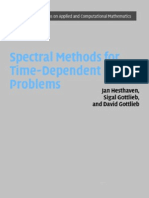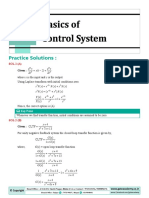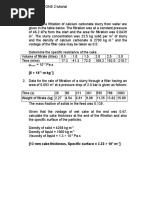Lecture Tutorial
Uploaded by
Ahmed A. RadwanLecture Tutorial
Uploaded by
Ahmed A. RadwanSPC318: System Modeling and Linear Systems
Lecture 5: Closed Loop Control Systems
Block Diagram Reduction & Manipulation
Dr. Haitham El-Hussieny
Adjunct Lecturer
Space and Communication Engineering
Zewail City of Science and Technology
Fall 2016
Dr. Haitham El-Hussieny SPC318: System Modeling and Linear Systems 1 / 40
Lecture Outline:
1 Block Diagram Representation.
2 Block Diagram Reduction Techniques.
3 Superposition of Multiple Inputs.
Dr. Haitham El-Hussieny SPC318: System Modeling and Linear Systems 2 / 40
Table of Contents
1 Block Diagram Representation.
2 Block Diagram Reduction Techniques.
3 Superposition of Multiple Inputs.
Dr. Haitham El-Hussieny SPC318: System Modeling and Linear Systems 3 / 40
Block Diagram Representation:
A Block Diagram is a shorthand pictorial representation of the cause-and-effect
relationship of a system.
The interior of the rectangle representing the block usually contains a description of or
the name of the element, gain, or the symbol for the mathematical operation to be
performed on the input to yield the output.
The arrows represent the direction of information or signal flow.
Dr. Haitham El-Hussieny SPC318: System Modeling and Linear Systems 4 / 40
Block Diagram Representation:
Addition and Substraction:
The operations of addition and subtraction have a special representation.
The block becomes a small circle, called a summing point, with the appropriate plus or
minus sign associated with the arrows entering the circle.
The output is the algebraic sum of the inputs.
Any number of inputs may enter a summing point.
We may put a cross in the circle.
Dr. Haitham El-Hussieny SPC318: System Modeling and Linear Systems 5 / 40
Block Diagram Representation:
takeoff (pickoff) point:
In order to have the same signal or variable be an input to more than one block or
summing point, a takeoff (or pickoff) point is used.
This permits the signal to proceed unaltered along several different paths to several
destinations.
Dr. Haitham El-Hussieny SPC318: System Modeling and Linear Systems 6 / 40
Block Diagram Representation:
Examples:
Example 1
Draw the block diagram for the following equations:
1 x3 = a1 x1 + a2 x2 − 5
dx1 1R
2 x 2 = a1 + x1 dt
dt b
d 2 x2 dx1
3 x3 = a1 2 + 3 − bx1
dt dt
(2)
(1) (3)
Dr. Haitham El-Hussieny SPC318: System Modeling and Linear Systems 7 / 40
Block Diagram Representation:
Canonical Form of A Feedback Control System:
Forward transfer function = G (s)
Feedback transfer function = H(s)
Open-loop transfer function = G (s)H(s)
Y (s) G (s)
Closed-loop transfer function = = (- for +ve feedback) (+ for -ve feedback)
R(s) 1 ± G (s)H(s)
E (s) 1
Error ratio = =
R(s) 1 ± G (s)H(s)
B(s) G (s)H(s)
Primary feedback ratio = =
R(s) 1 ± G (s)H(s)
Dr. Haitham El-Hussieny SPC318: System Modeling and Linear Systems 8 / 40
Block Diagram Representation:
Canonical Form of A Feedback Control System:
Closed-loop transfer function:
Y (s) G (s)
=
R(s) 1 ± G (s)H(s)
The denominator of closed loop transfer function determines the characteristic equation of
the system.
1 ± G (s)H(s) = 0 characteristic equation
Dr. Haitham El-Hussieny SPC318: System Modeling and Linear Systems 9 / 40
Block Diagram Representation:
Canonical Form of A Feedback Control System:
Example:
K
Forward transfer function = G (s) =
(1 + K )s + 1
Feedback transfer function = H(s) = 0.1
0.1K
Open-loop transfer function = G (s)H(s) =
(1 + K )s + 1
Closed-loop transfer function =
Y (s) G (s) K
= =
R(s) 1+G (s)H(s) (1 + K )s + (1 + 0.1K )
Characteristic equation: 1 + G (s)H(s) = 0 (1 + K )s + 1 + 0.1K = 0
1
Open loop poles and zeros if K = 10: (no zero) (po = − )
1+K
1 + 0.1K
Closed loop poles and zeros if K = 10: (no zero) (pc = − )
1+K
Dr. Haitham El-Hussieny SPC318: System Modeling and Linear Systems 10 / 40
Table of Contents
1 Block Diagram Representation.
2 Block Diagram Reduction Techniques.
3 Superposition of Multiple Inputs.
Dr. Haitham El-Hussieny SPC318: System Modeling and Linear Systems 11 / 40
Block Diagram Reduction Techniques:
1 Combining blocks in cascade:
2 Combining blocks in parallel:
3 Eliminating a feedback loop:
Dr. Haitham El-Hussieny SPC318: System Modeling and Linear Systems 12 / 40
Block Diagram Reduction Techniques:
Example:
Reduce the Block Diagram to Canonical Form:
(3) Feedback:
(1) Cascaded:
(2) Parallel:
(4) Canonical Form:
Dr. Haitham El-Hussieny SPC318: System Modeling and Linear Systems 13 / 40
Block Diagram Reduction Techniques:
Lecture Assignment:
For the system represented by the following
block diagram determine:
1 Open loop transfer function.
2 Feed Forward Transfer function.
3 Control ratio.
4 Feedback ratio.
5 Error ratio.
6 Closed loop transfer function.
7 Characteristic equation.
8 Closed loop poles and zeros if K = 100.
Dr. Haitham El-Hussieny SPC318: System Modeling and Linear Systems 14 / 40
Block Diagram Reduction Techniques:
4 Moving a summing point after a block:
7 Moving a pickoff point before a block:
5 Moving a summing point before a block:
8 Swap with two neighboring summing
points:
6 Moving a pickoff point after a block:
Dr. Haitham El-Hussieny SPC318: System Modeling and Linear Systems 15 / 40
Block Diagram Reduction Techniques:
Example:
Reduce the Block Diagram to Canonical Form:
Dr. Haitham El-Hussieny SPC318: System Modeling and Linear Systems 16 / 40
Block Diagram Reduction Techniques:
Example:
(1) Move summing point before a block:
Dr. Haitham El-Hussieny SPC318: System Modeling and Linear Systems 17 / 40
Block Diagram Reduction Techniques:
Example:
(2) Cascaded blocks:
Dr. Haitham El-Hussieny SPC318: System Modeling and Linear Systems 18 / 40
Block Diagram Reduction Techniques:
Example:
(3) Swap neighbor summing points:
Dr. Haitham El-Hussieny SPC318: System Modeling and Linear Systems 19 / 40
Block Diagram Reduction Techniques:
Example:
(4) Eliminate feedback:
Dr. Haitham El-Hussieny SPC318: System Modeling and Linear Systems 20 / 40
Block Diagram Reduction Techniques:
Example:
(5) Cascaded blocks:
Dr. Haitham El-Hussieny SPC318: System Modeling and Linear Systems 21 / 40
Block Diagram Reduction Techniques:
Example:
(6) Eliminate feedback:
Dr. Haitham El-Hussieny SPC318: System Modeling and Linear Systems 22 / 40
Block Diagram Reduction Techniques:
Example:
Try it yourself!
Dr. Haitham El-Hussieny SPC318: System Modeling and Linear Systems 23 / 40
Table of Contents
1 Block Diagram Representation.
2 Block Diagram Reduction Techniques.
3 Superposition of Multiple Inputs.
Dr. Haitham El-Hussieny SPC318: System Modeling and Linear Systems 24 / 40
Superposition of Multiple Inputs:
To find the total response in the case of multiple inputs:
1 Set all inputs except one equal to zero.
2 Transform the block diagram to canonical form, using the reduction techniques.
3 Calculate the response due to the chosen input acting alone.
4 Repeat step 1 to 3 for the other remaining inputs.
5 Algebraically add all of the responses (output) obtained in steps 1 to 4. This sum is the
total output of the system with all inputs acting in the same time.
Dr. Haitham El-Hussieny SPC318: System Modeling and Linear Systems 25 / 40
Superposition of Multiple Inputs:
Example:
Determine the output C due to inputs R and U using the Superposition Method.
Dr. Haitham El-Hussieny SPC318: System Modeling and Linear Systems 26 / 40
Superposition of Multiple Inputs:
Example:
(1) Put U = 0, the system reduces to:
G1 G2
CR = R
1 + G1 G2
Dr. Haitham El-Hussieny SPC318: System Modeling and Linear Systems 27 / 40
Superposition of Multiple Inputs:
Example:
(2) Put R = 0, replace the negative feedback with −1 block:
Dr. Haitham El-Hussieny SPC318: System Modeling and Linear Systems 28 / 40
Superposition of Multiple Inputs:
Example:
(3) Rearrange the block diagram:
Dr. Haitham El-Hussieny SPC318: System Modeling and Linear Systems 29 / 40
Superposition of Multiple Inputs:
Example:
(4) Convert the −1 block into the summing point:
G2
CU = U
1 + G1 G2
Dr. Haitham El-Hussieny SPC318: System Modeling and Linear Systems 30 / 40
Superposition of Multiple Inputs:
Example:
(5) The total response is:
G1 G2 G2
C = CR + CU = R+ U
1 + G1 G2 1 + G1 G2
Dr. Haitham El-Hussieny SPC318: System Modeling and Linear Systems 31 / 40
Superposition of Multiple Inputs:
Example:
Do it yourself!
Find the total system response C due to inputs R,U1 and U2 .
Dr. Haitham El-Hussieny SPC318: System Modeling and Linear Systems 32 / 40
Superposition of Multiple Inputs Multiple Outputs:
Example:
Determine the output C1 and C2 due to inputs R1 and R2 using the Superposition Method.
Dr. Haitham El-Hussieny SPC318: System Modeling and Linear Systems 33 / 40
Superposition of Multiple Inputs:
Example:
(1) Ignoring the output C2 :
Dr. Haitham El-Hussieny SPC318: System Modeling and Linear Systems 34 / 40
Superposition of Multiple Inputs:
Example:
(2) Put R2 = 0, combining the summing points:
G1 R1
C11 =
1 − G1 G2 G3 G4
Dr. Haitham El-Hussieny SPC318: System Modeling and Linear Systems 35 / 40
Superposition of Multiple Inputs:
Example:
(3) Put R1 = 0:
G1 G3 G4 R1
C12 = −
1 − G1 G2 G3 G4
So, the total output C1 = C11 + C12
Dr. Haitham El-Hussieny SPC318: System Modeling and Linear Systems 36 / 40
Superposition of Multiple Inputs:
Example:
(4) From the original block ignore C1 :
Dr. Haitham El-Hussieny SPC318: System Modeling and Linear Systems 37 / 40
Superposition of Multiple Inputs:
Example:
(5) Put R1 = 0:
G4 R2
C22 =
1 − G1 G2 G3 G4
Dr. Haitham El-Hussieny SPC318: System Modeling and Linear Systems 38 / 40
Superposition of Multiple Inputs:
Example:
(5) Put R2 = 0:
G1 G2 G4 R1
C21 = −
1 − G1 G2 G3 G4
So, the total output C2 = C21 + C22
Dr. Haitham El-Hussieny SPC318: System Modeling and Linear Systems 39 / 40
End of Lecture
Best Wishes
haitham.elhussieny@gmail.com
Dr. Haitham El-Hussieny SPC318: System Modeling and Linear Systems 40 / 40
You might also like
- F Amadeo Giannini-Worlds Beyond The Poles.o PDF100% (9)F Amadeo Giannini-Worlds Beyond The Poles.o PDF139 pages
- Spectral Methods For Time-Dependent ProblemsNo ratings yetSpectral Methods For Time-Dependent Problems281 pages
- (Chemistry Drugs Poisons) Homemade Cyanide and Ricin100% (9)(Chemistry Drugs Poisons) Homemade Cyanide and Ricin7 pages
- Lecture 1 Introduction Review of Classical ControlNo ratings yetLecture 1 Introduction Review of Classical Control88 pages
- Lab Experiment 8: Effect of Feedback On Disturbance & Control System Design ObjectiveNo ratings yetLab Experiment 8: Effect of Feedback On Disturbance & Control System Design Objective3 pages
- The Physics of Zombies: Madore's Rules of Zombie Cohesion, Zombie Cells and Super Cells, Zombie Black Holes, Zombie Cell Stress-Fission and Zombie Quirks100% (1)The Physics of Zombies: Madore's Rules of Zombie Cohesion, Zombie Cells and Super Cells, Zombie Black Holes, Zombie Cell Stress-Fission and Zombie Quirks19 pages
- 2 Basic Root Locus Analysis and Examples PDFNo ratings yet2 Basic Root Locus Analysis and Examples PDF26 pages
- Describing Function: Analysis of Nonlinear SystemsNo ratings yetDescribing Function: Analysis of Nonlinear Systems12 pages
- Digital Control: Fundamentals: ENGI 7825: Control Systems II Andrew VardyNo ratings yetDigital Control: Fundamentals: ENGI 7825: Control Systems II Andrew Vardy32 pages
- Lecture 1 Introduction To Nonlinear Control SystemsNo ratings yetLecture 1 Introduction To Nonlinear Control Systems44 pages
- IntroCtrlSys - Final Exam - 1st Semester - 1920 - Solution PDFNo ratings yetIntroCtrlSys - Final Exam - 1st Semester - 1920 - Solution PDF5 pages
- Modeling of Physical Systems Using Simulink.: Control System Lab 3No ratings yetModeling of Physical Systems Using Simulink.: Control System Lab 38 pages
- Design Via Root Locus and Frequency ResponseNo ratings yetDesign Via Root Locus and Frequency Response15 pages
- Pulse Transfer Function and Manipulation of Block Diagrams: The Output Signal Is Sample To ObtainNo ratings yetPulse Transfer Function and Manipulation of Block Diagrams: The Output Signal Is Sample To Obtain41 pages
- Lab 1: Systems Modeling in Simulink Using Differential EquationsNo ratings yetLab 1: Systems Modeling in Simulink Using Differential Equations23 pages
- Digital Control Systems: Stability Analysis of Discrete Time Systems100% (1)Digital Control Systems: Stability Analysis of Discrete Time Systems33 pages
- Electrical Engineering Forenoon SessionNo ratings yetElectrical Engineering Forenoon Session29 pages
- MECE 3350 - Control Systems - Lecture5 - CNo ratings yetMECE 3350 - Control Systems - Lecture5 - C31 pages
- Control Systems PID Controller Solved ManualNo ratings yetControl Systems PID Controller Solved Manual17 pages
- Control-Systems - FINAL -محاضرات 2019-2020No ratings yetControl-Systems - FINAL -محاضرات 2019-2020100 pages
- SPC318: System Modeling and Linear SystemsNo ratings yetSPC318: System Modeling and Linear Systems43 pages
- Polar & Nyquist Plots: Multiple Choice Questions For Online ExamNo ratings yetPolar & Nyquist Plots: Multiple Choice Questions For Online Exam18 pages
- Speed Control of D.C Motor With 2 Quadrant ChopperNo ratings yetSpeed Control of D.C Motor With 2 Quadrant Chopper4 pages
- 351 - 27435 - EE417 - 2019 - 1 - 1 - 1 - 0 3 Lec3 EE418 Block Diagram ReductionNo ratings yet351 - 27435 - EE417 - 2019 - 1 - 1 - 1 - 0 3 Lec3 EE418 Block Diagram Reduction70 pages
- Lec_10_ 11_Introduction to Block diagramsNo ratings yetLec_10_ 11_Introduction to Block diagrams56 pages
- Student Solutions Manual to Accompany Economic Dynamics in Discrete Time, secondeditionFrom EverandStudent Solutions Manual to Accompany Economic Dynamics in Discrete Time, secondedition4.5/5 (2)
- Chemical Process Principles (CLB 10904) Tutorial 1 Chapter 1: Basic Concepts (Part 1)No ratings yetChemical Process Principles (CLB 10904) Tutorial 1 Chapter 1: Basic Concepts (Part 1)4 pages
- Definition 1: Definition 2:: Work Is A Transfer of EnergyNo ratings yetDefinition 1: Definition 2:: Work Is A Transfer of Energy3 pages
- 10 Chapter Electrochemistry Text Book ExerciseNo ratings yet10 Chapter Electrochemistry Text Book Exercise31 pages
- 01 - Measurement, Uncertainty, and DeviationNo ratings yet01 - Measurement, Uncertainty, and Deviation9 pages
- SDBC Construction Procedures-Vqc NLGD-DT 16.2.2015No ratings yetSDBC Construction Procedures-Vqc NLGD-DT 16.2.201514 pages
- 2018 Grade 10 Maths Third Term Paper With Answers English Medium North Western ProvinceNo ratings yet2018 Grade 10 Maths Third Term Paper With Answers English Medium North Western Province12 pages
- Future / Current Program Read Across Worksheet:: Master PFMEA / Lessons LearnedNo ratings yetFuture / Current Program Read Across Worksheet:: Master PFMEA / Lessons Learned52 pages
- (Chemistry Drugs Poisons) Homemade Cyanide and Ricin(Chemistry Drugs Poisons) Homemade Cyanide and Ricin
- Lecture 1 Introduction Review of Classical ControlLecture 1 Introduction Review of Classical Control
- Lab Experiment 8: Effect of Feedback On Disturbance & Control System Design ObjectiveLab Experiment 8: Effect of Feedback On Disturbance & Control System Design Objective
- The Physics of Zombies: Madore's Rules of Zombie Cohesion, Zombie Cells and Super Cells, Zombie Black Holes, Zombie Cell Stress-Fission and Zombie QuirksThe Physics of Zombies: Madore's Rules of Zombie Cohesion, Zombie Cells and Super Cells, Zombie Black Holes, Zombie Cell Stress-Fission and Zombie Quirks
- Describing Function: Analysis of Nonlinear SystemsDescribing Function: Analysis of Nonlinear Systems
- Digital Control: Fundamentals: ENGI 7825: Control Systems II Andrew VardyDigital Control: Fundamentals: ENGI 7825: Control Systems II Andrew Vardy
- Lecture 1 Introduction To Nonlinear Control SystemsLecture 1 Introduction To Nonlinear Control Systems
- IntroCtrlSys - Final Exam - 1st Semester - 1920 - Solution PDFIntroCtrlSys - Final Exam - 1st Semester - 1920 - Solution PDF
- Modeling of Physical Systems Using Simulink.: Control System Lab 3Modeling of Physical Systems Using Simulink.: Control System Lab 3
- Pulse Transfer Function and Manipulation of Block Diagrams: The Output Signal Is Sample To ObtainPulse Transfer Function and Manipulation of Block Diagrams: The Output Signal Is Sample To Obtain
- Lab 1: Systems Modeling in Simulink Using Differential EquationsLab 1: Systems Modeling in Simulink Using Differential Equations
- Digital Control Systems: Stability Analysis of Discrete Time SystemsDigital Control Systems: Stability Analysis of Discrete Time Systems
- Polar & Nyquist Plots: Multiple Choice Questions For Online ExamPolar & Nyquist Plots: Multiple Choice Questions For Online Exam
- Speed Control of D.C Motor With 2 Quadrant ChopperSpeed Control of D.C Motor With 2 Quadrant Chopper
- 351 - 27435 - EE417 - 2019 - 1 - 1 - 1 - 0 3 Lec3 EE418 Block Diagram Reduction351 - 27435 - EE417 - 2019 - 1 - 1 - 1 - 0 3 Lec3 EE418 Block Diagram Reduction
- Student Solutions Manual to Accompany Economic Dynamics in Discrete Time, secondeditionFrom EverandStudent Solutions Manual to Accompany Economic Dynamics in Discrete Time, secondedition
- Chemical Process Principles (CLB 10904) Tutorial 1 Chapter 1: Basic Concepts (Part 1)Chemical Process Principles (CLB 10904) Tutorial 1 Chapter 1: Basic Concepts (Part 1)
- Definition 1: Definition 2:: Work Is A Transfer of EnergyDefinition 1: Definition 2:: Work Is A Transfer of Energy
- SDBC Construction Procedures-Vqc NLGD-DT 16.2.2015SDBC Construction Procedures-Vqc NLGD-DT 16.2.2015
- 2018 Grade 10 Maths Third Term Paper With Answers English Medium North Western Province2018 Grade 10 Maths Third Term Paper With Answers English Medium North Western Province
- Future / Current Program Read Across Worksheet:: Master PFMEA / Lessons LearnedFuture / Current Program Read Across Worksheet:: Master PFMEA / Lessons Learned

























































































